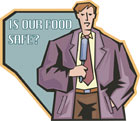
In newspapers and journals, on the Internet and in various media broadcast outlets, a recurring theme is that our food supply is at risk. The reports say we don’t inspect enough of the products shipped into our country; there are not enough inspectors; and food safety problems are the fault of agribusiness, large corporations or the Bush administration.
Some people think more regulations and inspections are the best ways to produce safer foods. Yet, meat and poultry processors are under continuous inspection by USDA representatives, and people still get sick from chicken, turkey, beef and processed meats. And, if there is a problem at a facility under continuous inspection, the USDA takes no responsibility.
The US government has mandated HACCP for seafood, juice, and meat and poultry, and given the events of September 2006 with spinach, fresh-cut produce will probably have a similar mandate. However, regulations are not the answer; stiffer penalties may be.
The best way to ensure food safety is industry commitment to partnering. For example, the large players in the fresh-cut industry know that sharing ideas and technology is good business. A problem at a small processor will affect the entire industry, so helping out is smart.
Incoming product inspection
FDA and customs officials are under attack because they inspect only 1% of incoming goods. Is this criticism warranted? Yes, because there should probably be more inspection; and no, because even if they did inspect everything, they would not uncover every problem.Current testing and analysis programs address known hazards or contaminants. Consequently, no one would have tested for melamine up until a few months ago. Regulators acknowledge they appear to be operating in a reactive rather than a proactive mode more often than they would like. But new issues continue to crop up.
Inspection at the ports is not random and haphazard. It is based on risk. The risk equation takes into account type of product, country of origin and past history. For example, canned foods from the European Union are a low risk and probably not worth the effort, but product from China is a different story. Over 250 shipments from China were rejected in April 2007.
Is our food supply less safe? I don’t think so. Outbreaks and problems do, however, get much more attention than they once did. Rather than dwelling on the problems, I would like to see a media story on what is being done correctly. For example, how Jack-in-the-Box has avoided problems for the past 14 years.
As an industry, we can always do better. Any processor that doesn’t have a program for continuous improvement is placing itself at a competitive disadvantage.

